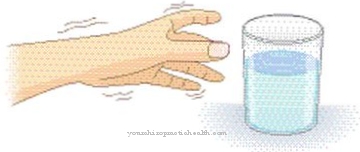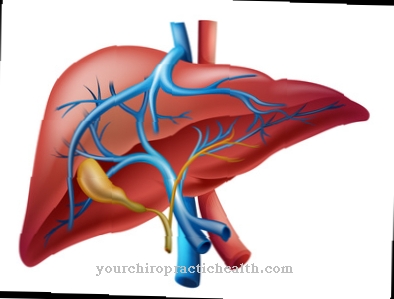Cloudy urine (cloudy urine) occurs relatively often. It doesn't necessarily have to be a disease. In most cases, the cloudiness caused by sediments in the urine is diet-related. The cloudy urine can smell strong or neutral. The urine can also be changed in color. If a persistent urine opacity is accompanied by further symptoms, you should see a doctor.
What is cloudy urine?
.jpg)
Urine that is not clear yellow in color is called cloudy urine. Instead of being transparent, it appears milky and less transparent than usual. Undissolved salts and sediments are responsible for this. The color of the urine can also be changed if the urine is cloudy.
The color of the urine, however, is a separate assessment criterion for cloudy urine. The degree of cloudiness, odor and color of the urine can indicate possible sources of the disease.
causes
The causes of urine obstruction are manifold. In most cases, eating habits are responsible for cloudy urine. In this case, cloudy urine is almost always harmless. Urinary opacity can also occur due to various diseases. These include bladder infections, urinary tract infections and kidney stones.
Cloudy urine can also indicate an inflamed prostate. Antibacterial inflammation of the prostate can be triggered by disturbances in urination. Urine residues in the prostate gland cause inflammation and urinary opacity through metabolic products. In addition, the urine becomes cloudy with a kidney infection. Remnants of pus and blood particles can indicate other diseases if the urine is cloudy. Urine opacity also occurs with tuberculosis disease.
The urine excreted is usually clear. Most of the particles excreted in the urine have dissolved. The dissolved components are invisible to the human eye. If you let clear urine cool down longer, however, sediments will precipitate. Excess and undissolved salts become visible as urine turbidity. It can also be bacteria, fungi, pus and mucus particles that have been removed. Lipids are rarely the cause of urinary opacity. Cloudiness caused by undissolved urine salts can be clearly distinguished from cloudiness caused by pus particles in the laboratory.
Diseases with this symptom
- Inflammation of the kidneys
- Prostatitis
- tuberculosis
- Kidney stones
- Cystitis
- Urinary tract infection
Diagnosis & course
You should only see a doctor in the event of an illness with further symptoms. The diagnosis of urinary obstruction can be made with a routine urine test. Both the visual sample and the test strip show the urine cloudiness. However, it does not have to result in a disease report.
First of all, it should be clarified what caused the urine cloudiness. A urine status is created for this purpose. He studies color, smell and sediment formation. The further course depends on the diagnosis of the disease. A diet-related urine cloudiness disappears again. If necessary, diet changes are useful. Cloudy urine caused by illness is only a side effect.
The underlying disease is always treated. Further urine tests are necessary to determine this. The urine is warmed up in the laboratory. It can be mixed with acetic acid, hydrochloric acid or sodium hydroxide solution.Test strips, microscopic analyzes and the creation of bacterial cultures provide information.
If the cloudy urine shows blood particles or pus residues, the patient must be examined more closely. The course of the disease varies depending on the diagnosis. Treatment of the underlying disease also affects urinary opacity.
Complications
Cloudy urine is usually a harmless and temporary phenomenon. This is especially true if the urine is cloudy. However, cloudy urine can also be a symptom of serious illnesses. A red to reddish brown urine cloudiness is often a warning sign.
Together with yellowing of the skin, the mucous membranes and the conjunctiva of the eyes, this type of urinary opacity occurs in jaundice in the context of severe liver or biliary diseases. Even with severe urinary tract infections, the urine can sometimes be cloudy red if there is bleeding in the ureter or bladder. Black skin cancer, melanoma, can also cause the urine to be cloudy red to reddish brown.
Some serious metabolic or liver diseases are associated with hemolysis. The red blood pigment is broken down with the result that the urine turns red. Red urine can also occur in the run-up to kidney stones, gout or gout-like joint inflammation. Even if the urine is milky, white cloudy, it could be a serious underlying condition.
If, for example, the lymph drainage is blocked in the case of lymph tumors, infestation with roundworms or adhesions in the lymphatic system, fatty lymph from the digestive tract enters the urine and causes a milky cloudiness. In addition, cloudy urinary tract can be an indication of severe kidney disease or bacterial urinary tract disease.
When should you go to the doctor?
Cloudy urine can have harmless causes: for example, consuming certain foods such as citrus fruits and not drinking enough fluids can lead to discoloration. This phenomenon can also occur during pregnancy due to a change in diet. First of all, cloudy urine is nothing to worry about. However, if it does not clear up after drinking enough fluids and urinating several times, it could be a urinary tract infection or a bladder infection. If the infection has not yet progressed far, the symptoms can be alleviated with teas or over-the-counter medication from the pharmacy. This should occur within three days.
If symptoms such as burning sensation in the urethra, pungent odor in the urine or painful urination are added to the cloudiness, a doctor should be consulted. These could be signs of a bacterial infection of the bladder or other conditions such as kidney stones, prostatitis, or diabetes. A visit to the doctor quickly leads to a clear diagnosis and adequate treatment. Patients should also consult a doctor with fever, cramps and blood in the urine in order to avoid a complicated course of the disease. Self-medication is not advisable for these symptoms.
The family doctor can quickly determine an uncomplicated infection using a urine sample. A visit to the urologist is advisable for long-lasting or recurring symptoms.
Doctors & therapists in your area
Treatment & Therapy
First of all, the doctor clarifies the cause of the urinary obstruction. The frequency of urinary opacity is also an indication. If the urine is cloudy due to diet, no therapy is necessary.
If anything, a change in diet would be advisable. If the cloudy urine is due to the disease, the underlying disease is treated. A severe urinary tract infection often requires antibiotic treatment. Blood in the urine may indicate this. Mild urinary tract infections can be relieved by drinking bladder tea. With uncomplicated urinary tract infections, the urinary cloudiness usually disappears after a few days.
If the kidneys are the cause of the cloudy urine, the process is more complicated. In addition, antispasmodic preparations and pain relievers can be administered. Hot water bottles relieve accompanying pain. As the therapy progresses, the cloudy urine also disappears.
Outlook & forecast
The prognosis of urinary opacity depends on the cause of the symptom. If the turbidity of the urine is caused by insufficient fluid intake, the urine can look normal again within a short time by drinking more. Cloudy urine can occur as part of a urinary tract infection. This can be treated by increasing your fluid intake or by giving an antibiotic. After the infection has healed, the urine becomes clear again.
Cloudy urine can also be a side effect of kidney stones. The symptom recedes after successful treatment or the spontaneous removal of the stones. In men, inflammation of the prostate can be the cause of cloudy urine. Adequate hydration and treatment of the inflammation will clear the color of the urine.
Cloudy urine is rarely a sign of serious illness. However, the symptom can also be found in the context of cancer. Urinary opacity can be a side effect of bladder or prostate cancer. The cloudiness is mainly caused by blood particles in the urine. For the prognosis, the treatment of the underlying disease is in the foreground. Depending on the type and stage of the disease, the urine may become clear again.
prevention
There are a number of things that can be done to prevent urine obstruction. However, urine clouding cannot be completely prevented. Complex processes are responsible for this. Above all, a healthy diet is important in the case of frequent urinary problems.
You should also drink plenty of clear water or mineral water every day. A sufficient amount of liquid dissolves salts and sediments that need to be eliminated better. It is important to go to the toilet more often to prevent urine obstruction. If the urine accumulates in the bladder for a long time, sediments and salts accumulate there. The result is cloudy urine.
The development of kidney stones in connection with urinary obscuration is sometimes due to insufficient fluid intake. Older people in particular often need to drink more. But even young people do not take in enough drinking water. Instead, they prefer to drink sweetened colas.
You can do that yourself
Cloudy urine is usually a symptom of cystitis. This symptom is accompanied by a burning sensation and sometimes pain when urinating. In this case a doctor should be consulted. However, before medical treatment can take place, for example due to a delay that prevents the person concerned from seeing a doctor directly, the person concerned can take their own measures.
It is important to drink a lot, water or tea are best. There are also special bladder teas that can provide relief in the event of a cystitis. In addition, the person concerned should take it easy. The cloudiness of the urine can be reduced by such measures, but the cystitis is not always completely cured. If symptoms persist, a doctor should be consulted.
In most cases, however, cloudy urine is a sign that the person is not drinking enough fluids. This condition is known as dehydration, and it describes a person's lack of fluids. In this case, the fluid intake must be increased. It is also best to drink water and not coffee, which has a diuretic effect. The absorbed liquid is released again too quickly. It should be noted that an adult should consume around two liters of fluid a day.

.jpg)






















.jpg)



